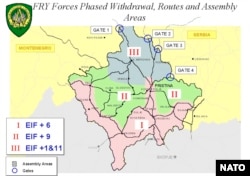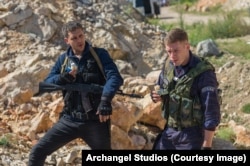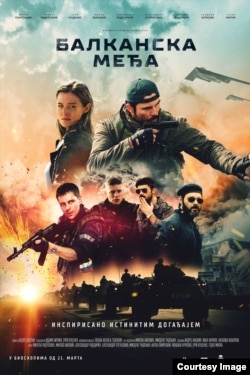Kosovo, June 1999. After a three-month NATO bombing campaign, then-Serbian President Slobodan Milosevic agrees to a ceasefire and to withdraw his military forces from the disputed region over 11 days. Russia, which opposed the NATO military campaign, secretly sends 250 paratroopers from a U.N. peacekeeping contingent in Bosnia to secure Slatina Airport in Pristina, the capital of the breakaway region. However, while the paratroopers make the 600-kilometer journey to the airport, Moscow tasks a team of Russian ex-special forces mercenaries with a clandestine operation, aimed at capturing the airport from armed Kosovar Albanian militants and repelling their counterattacks until reinforcements arrive.
That is the plot of “The Balkan Line,” a military action drama film that was jointly produced by the culture ministries of Russia and Serbia, released in March and distributed by 20th Century Fox of Russia. Since its release, Russian state media and Kremlin-friendly organizations have praised it for portraying the “truth” about what took place at the end of the Kosovo conflict.
There’s just one problem: the film’s plot is a near-total fabrication, and it is packed with distortions and unsubtle propaganda.
Kosovo 1999: What Did and Did Not Happen
In fact, Russian paratroopers unexpectedly arrived at Pristina airport ahead of NATO peacekeeping forces on the morning of June 12, 1999. Later, a contingent of British paratroopers arrived and, after a tense but short standoff, the Russians managed to get permission to participate in the peacekeeping mission, with their own sector to patrol in the northern part of the region. So how does a filmmaker manage to turn a minor spat, during which not a shot was fired, into a blockbuster action thriller? Simple: just add a massive set-piece battle that never happened.
In the film, a disgraced former Russian special forces officer, Aslan-bek "Bek" Yetkhoev, is tasked with a dangerous covert mission – to gather some of his former team members and take over Pristina airport from a group of marauding Kosovar Albanian militants (modeled on the Kosovo Liberation Army or KLA) who are using it as their headquarters. After that, they are to hold out until the Russian paratroopers arrive from Bosnia. (The character of Aslan-bek "Bek" Yetkhoev, played by actor Gosha Kutsenko, is based on Yunus-bek Yevkurov, the recently retired head of the Russian republic of Ingushetia, who led the Russian special forces contingent involved in the 1999 Pristina airport incident).
This plot line is entirely invented: Pristina airport at the time was controlled by Yugoslav Army, which turned it over to the Russians when they arrived. That was no secret in Russia, as even the Russian state-owned media outlet RT has acknowledged. Still, could the Yugoslav Army forces at the airport have been attacked by the Kosovo Liberation Army beforehand, breaking the siege just before the Russians’ arrival, similar to how the film depicts events?
The answer is no.
To understand why this was not possible, one must consider two key details from the war. The first is the disposition of the Yugoslav Army, which was in relatively good shape despite a 78-day NATO aerial bombing campaign. News footage from the time showed columns of Yugoslav troops and their vehicles retreating in good order, and subsequent analyses found that the bombing campaign inflicted few losses on the Yugoslav Army.
The second detail concerns the manner of the Yugoslav Army’s withdrawal from Kosovo, which was conducted according to the terms of the Kumanovo Agreement, also known as the Military Technical Agreement, which effectively ended the war.
Article II, section 2, of the Kumanovo Agreement read: “Phased Withdrawal of FRY Forces (ground): The FRY agrees to a phased withdrawal of all FRY Forces from Kosovo to locations in Serbia outside Kosovo.”
That part of the agreement was followed by instructions explaining how Yugoslav forces would withdraw and on which dates. A map was included for reference. Pristina was located within “Zone I,” and according to the agreement, Yugoslav forces were to be withdrawn from Zone I by “EIF + 6,” meaning six days after the agreement entered into force (EIF), which was June 9, 1999, the date the agreement was signed by all parties. The Yugoslav forces met the Russian paratroopers early on the morning of June 12, which was well within the deadline for evacuation for forces in Zone I. To the east and west of Pristina was Zone II, where forces were to withdraw by EIF + 9.
The upshot of all this is that while ethnic Albanians took reprisals against Serbian civilians after the war, Kosovo did not immediately collapse into chaos, as the film seems to imply. Moreover, Yugoslav forces were still relatively intact and sufficiently numerous in and around Pristina during the period depicted in the film.
In addition, retired General Wesley Clark, who was commander of NATO forces at the time, told Polygraph.info that the KLA was mostly active in the western part of the territory, which borders Albania. Successful insurgencies usually involve cross-border sanctuaries where insurgents can take shelter, train, and regroup in peace, and in the Kosovo War, both Albania and neighboring Macedonia offered such sanctuaries. Lastly and perhaps most importantly, the KLA forces are thought to have entered Pristina on or about June 12, the same day that Russian paratroopers were seen in control of the airport.
According to the book “Kosovo Liberation Army: The Inside Story of an Insurgency” by Henry H. Perrit Jr., the KLA forces were met by crowds of ethnic Albanians cheering them on. This fact, along with all the other evidence, demonstrates that the battle depicted in the film could not have possibly taken place.
Omitted Facts, Bizarre History
The film opens with a nearly incomprehensible scene that involves Russian special forces (spetsnaz) personnel in Bosnia and Herzegovina capturing a man who is later revealed to be a “war criminal.” The man and his nationality are never revealed, but a U.S. Army officer tells the Russians that he must be released. When the leader of the Russians, one of the film’s main protagonists, objects to freeing the prisoner, the American officer tells them they must “obey NATO,” and screams, “this is our territory!” While Russians participated in the U.N.-mandated peacekeeping operations in Bosnia and Herzegovina, the depiction of events in the film is clearly fabricated. In fact, NATO-Russian cooperation in Bosnia was considered very successful and the work of the Russian contingent was highly praised after it left.
The film’s opening scene is followed by text explaining the events of the Kosovo War. According to the film, the war was caused by ethnic Albanians in Kosovo demanding independence from Yugoslavia. It does not mention that Serbian leader Slobodan Milosevic revoked Kosovo’s autonomy in 1989 – an action widely seen as one of the main causes of the conflict. More importantly, the film ignores the Serbian government’s heavy-handed crackdown on ethnic Albanians and the security forces’ disproportionate response, which left many Albanian civilians, including women and children, dead. The text also says that the United Nations designated the Kosovo Liberation Army as a terrorist group. While U.N. Resolution 1160 refers to KLA terrorist activities, it condemns violence by both sides, including the Serbian police’s use of force against peaceful protesters.
Most importantly, the introduction fails to note that repeated atrocities against ethnic Albanians in Kosovo prompted NATO to act. Specifically, NATO moved into action after the Racak massacre, in which Serbian police shot 45 Albanian civilians. In “The Balkan Line,” Serbia is the blameless victim, while the Albanians are marauding beasts backed by an imperialist NATO.
Reactions
Russian Culture Minister Vladimir Medinsky gave “The Balkan Line” a thumbs-up.
“I watched the ‘The Balkan Line’. Though there was a large number of screenwriting shortcomings, this is a pretty decent movie. I would advise young people of draft age to watch it,” RIA Novosti quoted Medinsky as saying.
He added that he personally knew two Russian “participants” in the conflict in Yugoslavia, and that they told him “how it really was.”
It’s not clear whether Medinsky’s words about “screenwriting shortcomings” covered the fact that the film revolves around a major battle that did not happen. In fact, this is not the Culture Minister’s first rodeo when it comes to fabricated events on film.
The film “28 Panfilovtsev,” depicting the legendary battle of a small group of men against a larger German panzer unit in 1941, released in 2016, was financed in part by a grant from the Russian Ministry of Culture. The film was criticized for the fact that the battle of Panfilov’s 28 men was long ago exposed as a fabrication. In response, Medinsky personally lashed out at historians who criticized the film, calling them “washed up scum.”
In Serbia, the movie enjoyed major success. Predrag Milidrag, Senior Research Fellow at the Institute for Philosophy and Social Theory in Belgrade told Polygraph.info, "This movie has nothing to do with reality, but it is all young people in Serbia believe to have happened in Kosovo."
Milidrag said, "For the young people this is the real history, without any context, without knowledge about crimes and ethnic cleansing committed by the Serbian security services. For them NATO is the enemy, the Russians are friends. Kosovo 'was taken from us,' we did not lose it in a war..."








